The 10 Most Common Birds in North America
There are many rare birds in North America, and it’s exciting for birders who catch glimpses of these elusive birds. Many rare birds are endangered, and conservation efforts are critical. After all, we don’t want to lose them.
A focus on them, however, can make us forget the many wonderful birds we take for granted. These birds are abundant in our gardens, parks, and woods. Common birds in North America are birds who have learned to survive by adapting to their habitats, showing flexibility in their feeding habits, and learning to thrive in a changing world.
These wonderful birds fill our woods and backyard feeders with song and color. Here are the 10 most common birds in North America. We’ve included tips on attracting more of these charming, feathered friends.
How Common Are They?
Each of the listed species is estimated to have at least 100 million members in the United States, but it’s difficult to get exact numbers of bird populations. These are the bird types you are most likely to see in cities, towns, woods, and farms all over the continent.
How To Attract Common Birds To Your Backyard
Provide Water
All of these common birds in North America appreciate a water source, especially on the hot days of summer. All birds enjoy bathing, which they use to groom their feathers. Place the water source close to low-hanging branches, hedges, or shrubs. Water slows down their flight, and birds appreciate having shelter they can reach easily.
Use Good Birdseed
If you want to put out birdseed, don’t just buy the discount bag of mixed seeds you find at the store. Each bird type prefers a specific food, and it’s best to create a custom blend based on the birds you want to attract. Many birds appreciate a suet cake, especially one that has peanuts or berries.
Cheap, low-quality birdseed is high in millet and other ingredients that attract invasive species. These species, which include starlings and European house sparrows, can drive away the native birds you want to feed. Starlings and European house sparrows will destroy the nesting sites of bluebirds, woodpeckers, and other birds.
Feed According to the Seasons
Some wildlife experts say you should avoid feeding birds in the spring and summer when food is plentiful. They believe this will lessen their ability to fend for themselves. Also, commercial seed mixes are usually lower in nutrition than the birds’ natural diets. Others say it’s fine to feed all year because songbirds—whose populations are in decline—need all the help they can get.
Feeding in the fall and winter, when food is scarce, will attract many birds to your home. They will appreciate the supplemental food.
Use a Mix of Feeder Types
Birds like platform feeders, some like hanging tube feeders, and others like to feed on the ground. A little bit of research will help you learn which feeders you should use.
#10: Red-Bellied Woodpecker
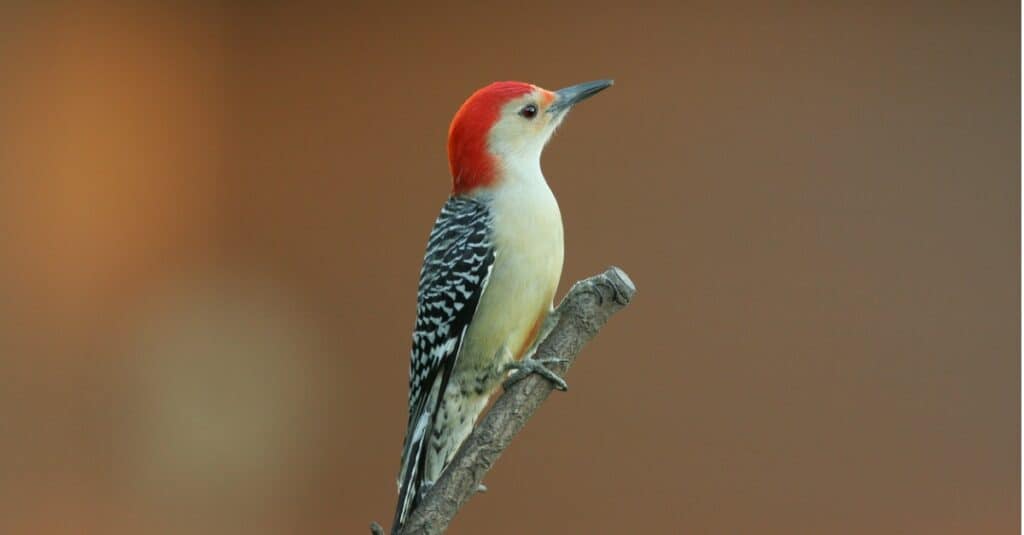
The name is confusing because the first thing you see is this beautiful bird’s bright red head. On closer inspection, you can see the faint wash of red that gives this common bird in North America its name. Identification of the red-bellied woodpecker is easy with its striking black and white feathers, long black bill, and bright red cap.
You can hear woodpeckers digging into trees in search of insects. Many people are charmed by the beauty of woodpeckers and the rhythmic noise of their pecking. If you’d like to see more of these birds in your yard, hang a feeder holding a suet cake made from suet, nuts, and berries. Many birds appreciate a hanging suet feeder in the winter, but woodpeckers will eat from it all year.
#9: Chickadee
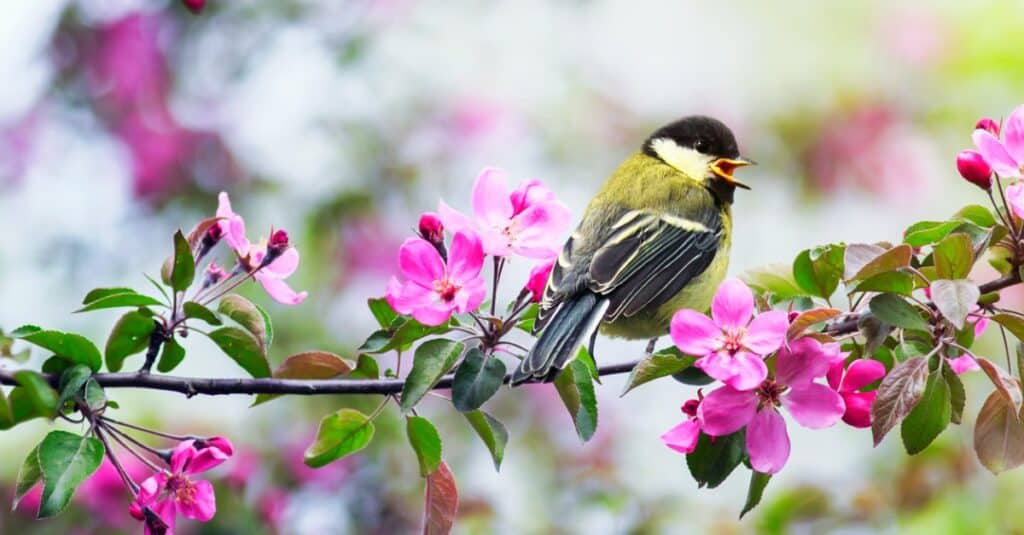
This cute little bird is a common visitor to backyards, parks, and gardens all over the United States. There are seven species of the chickadee, and each lives in a specific region of the country. The most common are the Carolina chickadee, black-capped chickadee, and chestnut-backed chickadee.
A chickadee is one of the smallest songbirds. It has a distinctly round body with a black cap, wide black collar, and round breast. For easy identification, look for a tiny bird whose eye may be hidden by its dark cap.
Chickadees live all over the United States. They prefer trees and woody shrubs, but they are highly adaptable to any environment. They prefer to nest in birch or alder trees. If you’d like to see more of these adorable birds in your yard, set out black oil sunflower seeds, sunflower hearts, or suet.
#8: Northern Cardinal
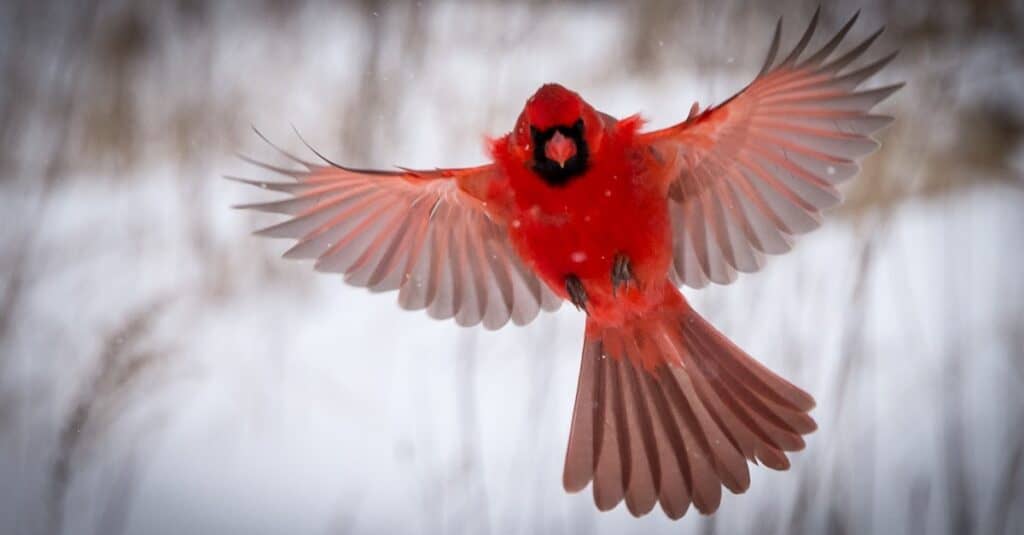
A bright red cardinal against a snowy backdrop is one of the most beautiful sights of winter. It graces Christmas cards and holiday scenes every year. The cardinal is a large red songbird that is the state bird of North Carolina.
Cardinals have a unique body and bill shape that make them easy to identify. The females have the same body and head shape as the males, but they are pale brown. Males are bright red with red bills.
They are popular visitors to urban and suburban bird feeders. If you want to attract cardinals, put out chopped peanuts, black oil sunflower seeds, and berries.
#7: Mallard
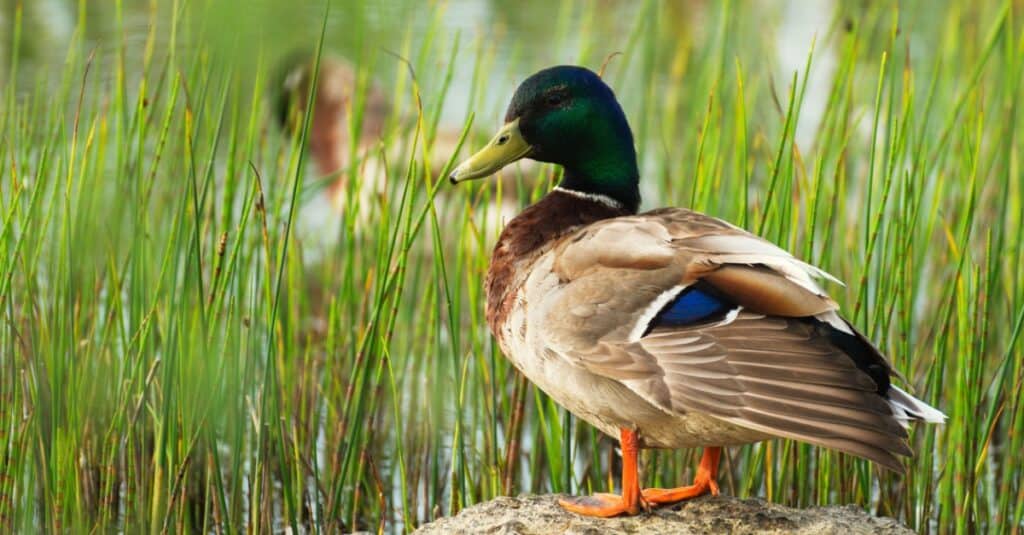
This common duck inhabits the waterways of almost every state in the United States. The male mallards are distinctive for their bright green heads, white-collar bands, and yellow bills. The females have a softer coloring of deep brown and gray. You are likely to see mallards when you visit lakes, ponds, and streams.
Mallards are dabbling ducks. They don’t dive. Instead, they dip their heads into the water to feed on underwater plants.
You are certain to see these playful, energetic birds on almost any body of water. Most mallards are used to being around humans, who often toss food to them in public areas. It is common to see them in large groups with other dabbling ducks.
#6: Red-Eyed Vireo

Although it’s very common, this pretty bird with greenish feathers is elusive and hard to spot. With their camouflage and their preference for building nests in dark foliage, vireos are good at hiding from view.
Vireos are large, chunky birds with long, slightly hooked bills. They are known for their lovely singing. Unlike many other birds, vireos continue singing in the hot summer months.
Vireos live on caterpillars and other insects. If you want to attract them, create an insect-friendly yard and plant the trees more likely to attract caterpillars, including maples, oaks, elderberries, wild cherry, and sumac.
#5: Chipping Sparrow
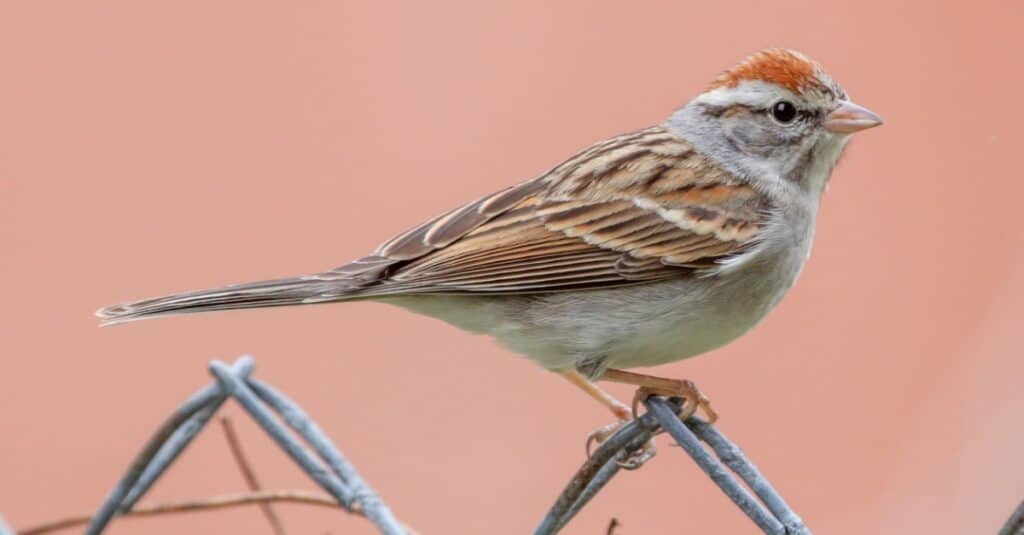
These small, common birds should not be confused with European house sparrows, which are an invasive, non-native species.
Chipping sparrows were once the most populous birds in North America, and they are still common. For the correct identification, look for a brightly colored cap. The chipping sparrow has a pale gray or cream breast, brown feathers, and a chestnut cap. It also has a distinct black eye line. Males and females look alike.
Chipping sparrows migrate south in the winter, and you can expect to see them when the weather gets warm. If you see a sparrow in your yard in the winter, it may be a winter sparrow, which is a visitor from Canada or Alaska. If you want to see more chipping sparrows in your yard, spread birdseed on the ground and grow native grasses in your yard.
#4: American Robin
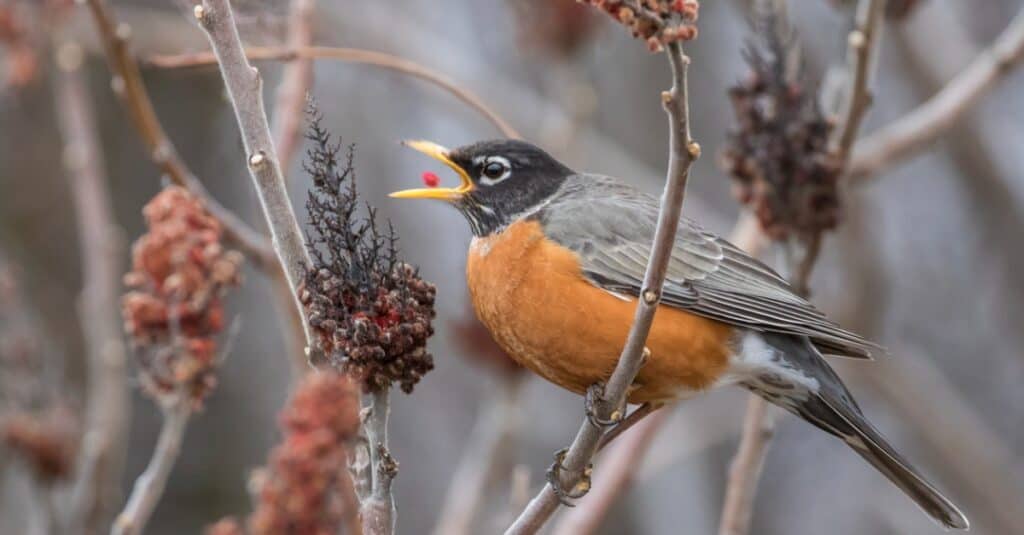
Robins were once forest dwellers. Like raccoons and other animals, they have learned to thrive in urban and suburban areas. They live all over Canada and in almost every state of the United States. Robins are a legendary herald of spring. Their bright red breasts and clear, ringing calls are classic elements of any backyard garden.
Robins have a distinct call that makes identification of them easy. Once you have heard it, you will always know when a robin is around.
Robins are not seed eaters. They like to eat fat, juicy worms, and slugs. If you’d like to attract more of them, create small piles of leaf litter around your yard. Leaf litter attracts worms and other insects that are the favorite food of robins and thrashers. Robins also eat tree berries, including chokecherries and dogwood.
#3: Mourning Dove
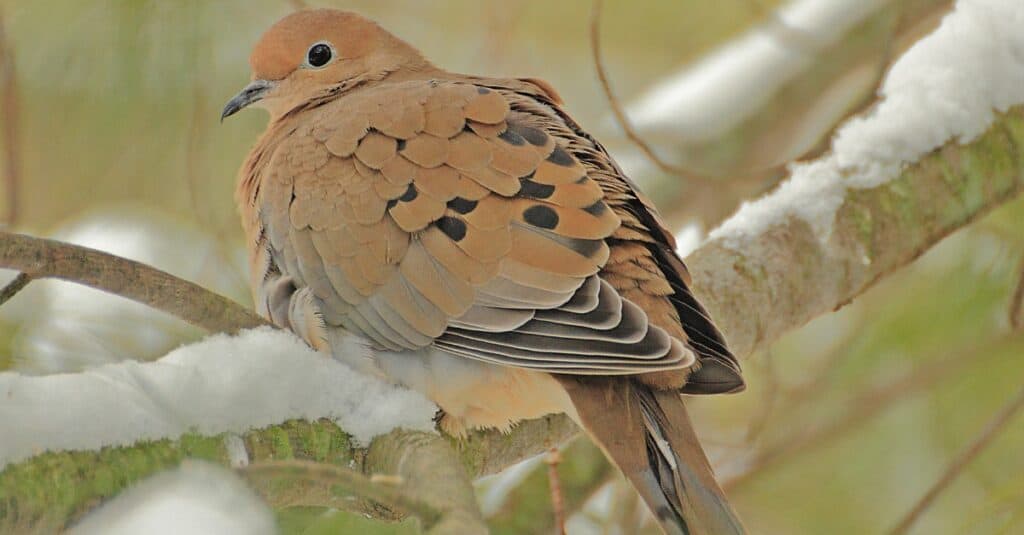
The mourning dove gets its name from its mournful, haunting call. Also known as the turtle dove, it is one of the most common birds in the United States. You will often spot them stepping gracefully on their ground, which is where they prefer to feed.
Mourning doves live all over the United States. It is common to see mourning doves in pairs. These birds are affectionate and mate for life. They don’t always migrate in the winter, so you can often enjoy them all year.
Do you want more of these graceful, year-round visitors? Mourning doves will return to a reliable feeding source, and it is easy to entice them to your yard. They enjoy cracked corn, sunflower seeds, wheat, and berries. Place these treats on a ground-level platform feeder or directly on the ground.
#2: Red-Winged Blackbird
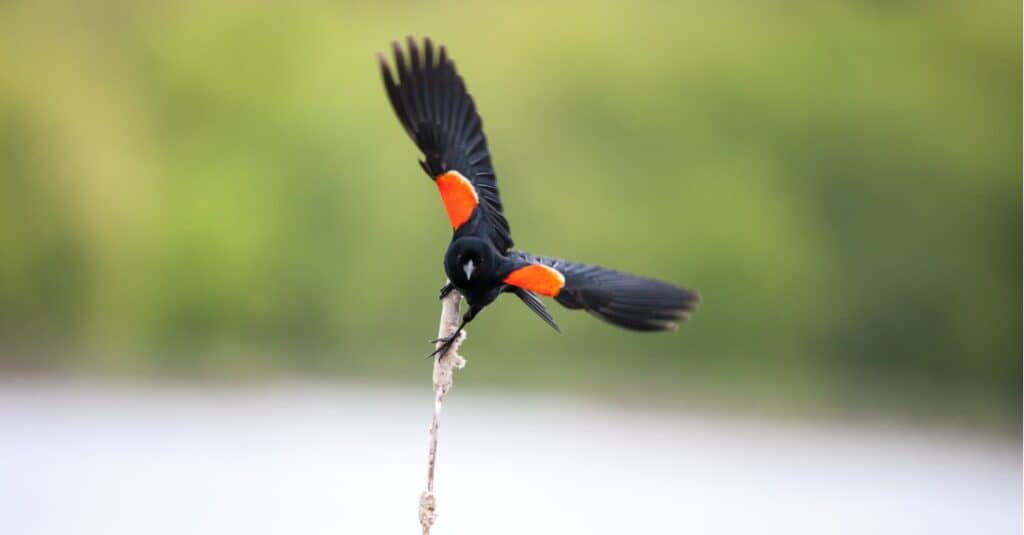
These large birds are striking with their dark black feathers. They look like regular blackbirds, but their shoulder feathers help with identification. The males sport bright red and yellow patches at the top of their wings. The females are less showy. Female red-winged blackbirds often have brown feathers.
Red-winged blackbirds prefer to live near wetlands. They eat seeds, slugs, and insects. Their adaptability has made them one of the most populous birds in North America. They are found in Canada, Mexico, and every state of the United States.
Do you want to see more red-winged blackbirds in your yard? It helps if you live near a wetlands area and hang a suet feeder in the trees.
#1: Dark-Eyed Junco
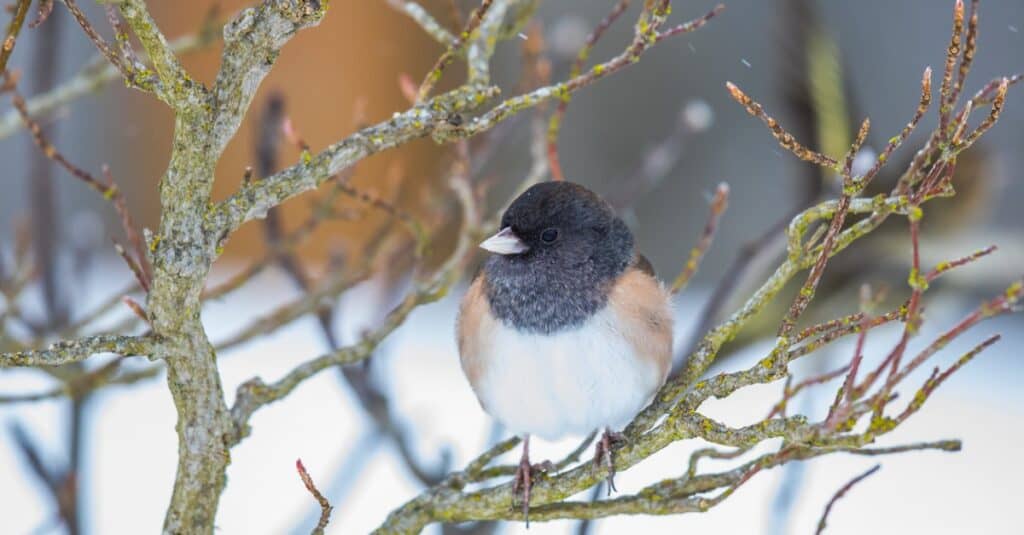
Juncos look like fluffy gray balls. These energetic little birds may be the most numerous birds in North America. It’s common to see them hanging around your tree branches and making their loud, joyful noises.
Identification of these birds depends on where in the country you spot them. In the eastern states, they are gray and white, but out west, they come in various colors, including a reddish-brown.
Juncos are winter visitors who visit North America from even colder climates up north. Because of this, some people call them “snowbirds.” If you want to see more of them, spread cracked corn and sunflower seeds on ground-level feeders.
Next Up: 8 Animals That Can Kill An Elephant
